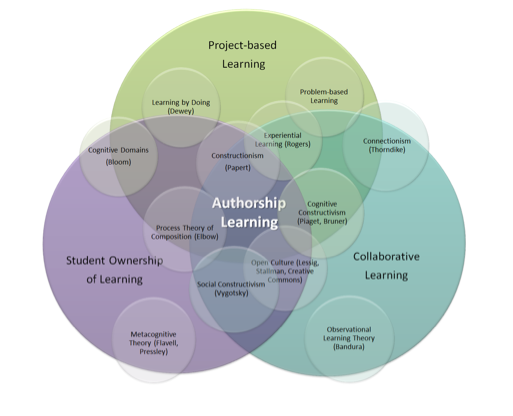
Paul James Gee uses good design and learning elements of video games as a metaphor for good learning. He lists 36 learning principles, which I will list below, that are easy to understand. However, for anyone that has had exposure to popular developmental and learning theory (e.g. Piaget, Vygotsky) can recognize quite a bit of similarity. I’m not sure if Gee recognizes the connection, but he never makes it. It seems that his argument would have been valid if he synthesized their widely credited work with his own. It seems that Gee is advocating for gaming, however he is simply using good video games as a metaphor for good learning. He never really says it though. I think that if he would have came right out in the beginning with a disclaimer the reader (you and me) could have read in with practical application in mind.
However, Gee makes a great argument. Well-designed games are motivating for most children. This is hard to argue. If you were to give the average students the choice to either play a game or engage in some other traditional type of learning, more often than not they would choose the game with an excited reply.
Learning how to play games is not unlike any other type of learning. Let us consider learning how to add and subtract fractions in a traditional school setting for an example. This particular skill can present challenges for many learners. It is challenging and tedious. There are many steps to remember. The steps must be done in a certain order. There is an entire new vocabulary to learn, words like “numerator” and “denominator”. The learner is tested, again and again. The exercises gets increasingly more complex. There is often a bit of anxiety and frustration involved. The information taught needs to be remembered, because the next skill being learned builds on the previous.
Well-designed games are not much different. Anyone that has played a role-playing game like World of Warcraft can attest to its complexity. It is a very difficult game to learn, initially. There is an entirely new language to learn. There are missions to complete (tests). The game gets harder as you progress. There is also frustration and anxiety involved (gamers would not bother with games that were too simple). Like any learning, it serves you best if it is remembered.
There is one significant difference between learning fractions in a traditional school setting and learning to play World of Warcraft. The game is a whole lot more fun to learn! Game designers are motivation magicians. Well-designed games like World of Warcraft, Deus Ex, and Time Machine (award-winning games) are difficult to learn and take an enormous amount of time to complete. So here we have something that is challenging, time consuming, hard to learn. Yet, the game industry sells millions of copies of these games each year. In fact, game designers focus on creating new and even more difficult games each year and still manages to get them learned. Game designers just may have something to teach educators about learning and teaching.
Learning Principles*
In his book, What Video Games Have to Teach Us about Learning and Literacy, James Paul Gee derives a set of learning principles from his study of the complex, self-directed learning each game player undertakes as s/he encounters and masters a new game. He suggests that adherence to these principles could transform learning in schools, colleges and universities, both for teachers and faculty and, most importantly, for students.
1) Active, Critical Learning Principle
All aspects of the learning environment (including ways in which the semiotic domain is designed and presented) are set up to encourage active and critical, not passive, learning.
2) Design Principle
Learning about and coming to appreciate design and design principles is core to the learning experience.
3) Semiotic Principle
Learning about and coming to appreciate interrelations within and across multiple sign systems (images, words, actions, symbols, artifacts, etc.) as a complex system is core to the learning experience.
4) Semiotic Domains Principle
Leaning involves mastering, at some level, semiotic domains, and being able to participate, at some level, in the affinity group or groups connected to them.
5) Meta-level thinking about Semiotic Domain Principle
Learning involves active and critical thinking about the relationships of the semiotic domain being learned to other semiotic domains.
6) “Psychosocial Moratorium” Principle
Learners can take risks in a space where real-world consequences are lowered.
7) Committed Learning Principle
Learners participate in extended engagement (lots of effort and practice) as an extension of their real-world identities in relation to a virtual identity to which they feel some commitment and a virtual world that they find compelling.
8) Identity Principle
Learning involves taking on and playing with identities in such a way that the learner has real choices (in developing the virtual identity) and ample opportunity to meditate on the relationship between new identities and old ones. There is a tripartite play of identities as learners relate, and reflect on, their multiple real-world identities, a virtual identity, and a projective identity.
9) Self-Knowledge Principle
The virtual world is constructed in such a way that learners learn not only about the domain but also about themselves and their current and potential capacities.
10) Amplification of Input Principle
For a little input, learners get a lot of output.
11) Achievement Principle
For learners of all levels of skill there are intrinsic rewards from the beginning, customized to each learner’s level, effort, and growing mastery. These rewards signal the learner’s ongoing achievements.
12) Practice Principle
Learners get lots and lots of practice in a context where the practice is not boring (i.e. in a virtual world that is compelling to learners on their own terms and where the learners experience ongoing success). They spend lots of time on task.
13. Ongoing Learning Principle
The distinction between the learner and the master is vague, since learners, thanks to the operation of the “regime of competency” principle listed next, must, at higher and higher levels, undo their routinized mastery to adapt to new or changed conditions. There are cycles of new learning, automatization, undoing automatization, and new re-organized automatization.
14) “Regime of Competence” Principle
The learner gets ample opportunity to operate within, but at the outer edge of, his or her resources, so that at those points things are felt as challenging but not “Undoable.”
15) Probing Principle
Learning is a cycle of probing the world (doing something); reflecting in and on this action and, on this basis, forming a hypothesis; reprobing the world to test this hypothesis; and then accepting or rethinking the hypothesis.
16) Multiple Routes Principle
There are multiple ways to make progress or move ahead. This allows learners to make choices and rely on their own strengths and styles of learning and problem-solving, while also exploring alternative styles
17) Situated Meaning Principle
The meanings of signs (words, actions, objects, artifacts, symbols, texts, etc.) are situated in embodied experience. Meanings are not general or decontextualized. Whatever generality meanings come to have is discovered bottom up via embodied experience.
18) Text Principle
Texts are not understood purely verbally (i.e. only in terms of the definitions of the words in the text and their text-internal relationships to each other) but are understood in terms of embodied experience. Learners move back and forth between texts and embodied experiences. More purely verbal understanding (reading texts apart from embodied action) comes only when learners have enough embodied experience in the domain and ample experiences with similar texts.
19) Intertextual Principle
The learner understands texts as a family (“genre”) of related texts and understands any one text in relation to others in the family, but only after having achieved embodied understandings of some texts. Understanding a group of texts as a family (“genre”) of texts is a large part of what helps the learner make sense of texts.
20) Multimodal Principle
Meaning and knowledge are built up through various modalities (images, texts, symbols, interactions, abstract design, sound, etc.), not just words.
21) “Material Intelligence” Principle
Thinking, problem solving, and knowledge are “stored” in material objects and the environment. This frees learners to engage their minds with other things while combining the results of their own thinking with the knowledge stored in material objects and the environment to achieve yet more powerful effects.
22) Intuitive Knowledge Principle
Intuitive or tacit knowledge built up in repeated practice and experience, often in association with an affinity group, counts a good deal and is honored. Not just verbal and conscious knowledge is rewarded.
23) Subset Principle
Learning even at its start takes place in a (simplified) subset of the real domain.
24) Incremental Principle
Learning situations are ordered in the early stages so that earlier cases lead to generalizations that are fruitful for later cases. When learners face more complex cases later, the learning space (the number and type of guesses the learner can make) is constrained by the sorts of fruitful patterns or generalizations the learner has founded earlier.
25) Concentrated Sample Principle
The learner sees, especially early on, many more instances of the fundamental signs and actions than should be the case in a less controlled sample. Fundamental signs and actions are concentrated in the early stages so that learners get to practice them often and learn them well.
26) Bottom-up Basic Skills Principle
Basic skills are not learned in isolation or out of context; rather, what counts as a basic skill is discovered bottom up by engaging in more and more of the game/domain or games/domains like it. Basic skills are genre elements of a given type of game/domain.
27) Explicit Information On-Demand and Just-in-Time Principle
The learner is given explicit information both on-demand and just-in-time, when the learner needs it or just at the point where the information can best be understood and used in practice.
28) Discovery Principle
Overt telling is kept to a well-thought-out minimum, allowing ample opportunities for the learner to experiment and make discoveries.
29) Transfer Principle
Learners are given support for, and ample opportunity to practice, transferring what they have learned earlier to later problems, including problems that require adapting and transforming that earlier learning.
30) Cultural Models about the World Principle
Learning is set up in such a way that learners come to think consciously and reflectively about some of their cultural models regarding the world (without denigration of their identities, abilities or social affiliations), and juxtapose them to new models that may conflict with or otherwise relate to them in various ways.
31) Cultural Models about Learning Principle
Learning is set up in such a way that learners come to think consciously and reflectively about their cultural models about learning and themselves as learners (without denigration of their identities, abilities, or social affiliations), and juxtapose them to new models of learning and themselves as learners.
32) Cultural Models about Semiotic Domains Principle
Learning is set up in such a way that learners come to think consciously and reflectively about their cultural models about a particular semiotic domain they are learning (without denigration of their identities, abilities, or social affiliations), and juxtapose them to new models about this domain.
33) Distributed Principle
Meaning/knowledge is distributed across the learner, objects, tools, symbols, technologies, and the environment.
34) Dispersed Principle
Meaning/knowledge is dispersed in the sense that the learner shares it with others outside the domain/game, some of whom the learner may rarely or never see face-to-face.
35) Affinity Group Principle
Learners constitute an “affinity group,” that is, a group that is bonded primarily through shared endeavours, goals, and practices and rather than shared race, gender, nation, ethnicity, or culture (although these may overlap).
36) Insider Principle
The learner is an “insider,” “teacher,” and “producer” (not just a consumer) able to customize the learning experience and the domain/game from the beginning and throughout the experience.







 Paul James Gee first discussed “affinity groups” in his book What Video Games Have to Teach Us about Language, Learning, and Literacy (Gee, 2007). Affinity groups are defined as the people that operate within a semiotic domain. You may ask yourself, “What in the heck is a semiotic domain?” Well, that’s just a fancy academic term for a place or where people use specific symbols or language to interact. Lets take, for example, a chemistry professor. This chemistry professor, lets call him Professor C teaches upper-division chemistry at a prestigious university. Every semester science majors fill his classes, textbooks in hand, laptops open, with a loose grasp of what exactly the periodic table is. Professor C is counting on this basic understanding, because he knows something that some of them also know, chemistry is difficult. There will a whole new language for them to learn, and there are numerous symbols used in chemistry that many students will have never seen before. In this example, Professor C belongs to the affinity group of chemist. He belongs to this group because he can understand and use the language and symbols of that particular semiotic domain (chemistry). If there were a students in his course pursuing chemistry as a profession for themselves, he or she would be in a similar situation that Keri Franklin found herself in when venturing into Twitter.
Paul James Gee first discussed “affinity groups” in his book What Video Games Have to Teach Us about Language, Learning, and Literacy (Gee, 2007). Affinity groups are defined as the people that operate within a semiotic domain. You may ask yourself, “What in the heck is a semiotic domain?” Well, that’s just a fancy academic term for a place or where people use specific symbols or language to interact. Lets take, for example, a chemistry professor. This chemistry professor, lets call him Professor C teaches upper-division chemistry at a prestigious university. Every semester science majors fill his classes, textbooks in hand, laptops open, with a loose grasp of what exactly the periodic table is. Professor C is counting on this basic understanding, because he knows something that some of them also know, chemistry is difficult. There will a whole new language for them to learn, and there are numerous symbols used in chemistry that many students will have never seen before. In this example, Professor C belongs to the affinity group of chemist. He belongs to this group because he can understand and use the language and symbols of that particular semiotic domain (chemistry). If there were a students in his course pursuing chemistry as a profession for themselves, he or she would be in a similar situation that Keri Franklin found herself in when venturing into Twitter.


 Website:
Website: